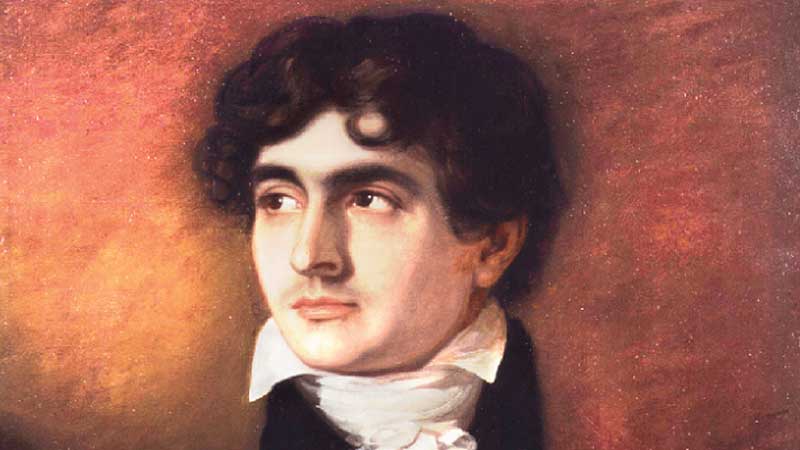DR KAJA FRANCK explores how the birth of Frankenstein also involved the creation of the first English vampire novel by John Polidori

2018 marks the 200 year anniversary of the publication of Mary Shelley’s Frankenstein (1818). The genesis of this novel is itself a Gothic narrative.
Most readers will be familiar with this tale: the young Mary Wollstonecraft Godwin and her fiancé, Percy Bysshe Shelley, travelling to the Villa Diodati on the shores of Lake Geneva, where Lord Byron and his physician Dr John Polidori were residing, after being forced to flee England due to rumours that Byron had had an affair with his half-sister Augusta Leigh.
They were accompanied by Mary’s stepsister Claire Clairmont, who, following an active seduction, found herself pregnant by Byron and hoped to secure his love for her.
They arrived in July 1816, sometimes referred to as the Year Without a Summer, as it epitomised the idea of ‘a dark and stormy night’.
The eruption of Mount Tambora in the Dutch East Indies, during 1815, precipitated a volcanic winter across much of Western Europe, leading to crops failing and wide spread famine. This dismal atmosphere and aberrant weather meant that the five travellers found themselves entombed inside the villa.
To pass the time, the group read Gothic novels and the recently published poem Christabel (1816) by Samuel Taylor Coleridge. The eponymous heroine of the poem rescues a beautiful but mysterious woman Geraldine. At one point during the poem, Geraldine’s bosom is described as ‘[a] sight to dream of, not to tell’.
As Byron recited this line, Shelley ran screaming from the room; he explained that he had hallucinated a woman with eyes for nipples whilst looking at his soon-to-be wife. (There is a distinct possibility that the group were intoxicated by more than just literature).
This darkly creative environment led to Mary’s infamous nightmare that became the basis of Frankenstein. However, it is not this text which I want to talk about, rather, I want to concentrate on another important, if overlooked, novel which was also birthed during that gloomy and fractious period, Polidori’s The Vampyre (1819).
John Polidori, England’s first vampire novelist
Polidori’s work is considered to be the first English vampire novel and its creation is, itself, wonderfully vampiric. By the time The Vampyre was published in New Monthly Magazine, Byron and Polidori had parted ways acrimoniously, at least partly due to Byron’s criticism of his physician’s writing skills.
Polidori’s novel is authorial revenge at its finest. The antihero of the novel is Lord Ruthven, seductive, charming and evil to the core. The name Lord Ruthven is an homage to Byron.
De Ruthven was the moniker given to him by his former lover, Lady Caroline Lamb, in her Gothic novel, Glenarvon (1816); she also described Byron as ‘mad, bad and dangerous to know’, a description which befits Lord Ruthven perfectly.
Though appearing to refuse the attentions of young society women in London, it becomes clear once Ruthven travels to mainland Europe, with the naïve hero of the story, Aubrey, that this is not the case.
Instead, it is discovered that ‘all those females whom he had sought, apparently on account of their virtue, had, since his departure, thrown even the mask aside, and had not scrupled to expose the whole deformity of their vices to the public gaze’ (The Vampyre).
Even worse, the most beautiful and innocent of Ruthven’s victims are killed, as he sates himself on their blood. Polidori parodies Byron’s behaviour in his depiction of the vampire.
Moreover, rather than being of peasant stock, as the earlier vampires of folklore, Ruthven is a gentleman, whose money and influence gains him access to the inner circles of London society. His money also allows him to disappear without having to face the consequences of his behaviour – something which Polidori may have felt was the case with Byron.
Confusingly, The Vampyre was attributed to Byron at first, having been published with a suggestive, anonymous letter from Polidori. Byron refuted this strongly, though later that year, he published his own vampiric text, ‘Fragment of a Novel’.
Part of a longer narrative, it tells the story of a young man, not unlike Polidori’s Aubrey, who travels to Greece with an influential, older gentleman, Augustus Darvell.
During the journey, Darvell appears to die and undergoes a burial, eliciting an oath from his young friend not to disclose his death when he returns to England.
On his return to London, the hero of the story discovers that Darvell is alive, a vampire and preying on our hero’s sister. Byron had decided upon this story during the Summer of 1816 and explained the rest of what he planned to the assembled group, allowing Polidori to write The Vampyre.
In doing so, Polidori turned the narrative against his former employer so that is could live, vampirically, on the reputation of Byron. Despite the inherent plagiarism in the creation of England’s first vampire novel, its complex origin caused a seismic shift in the figure of the vampire.
Rather than a grotesque re-animated corpse, the vampire is aligned with the Byronic hero: a darkly seductive being in the model of Milton’s Satan from Paradise Lost (1667).
Though not romantic, in the sense of more recent incarnations of the vampire, the Byronic vampire’s obsessive desire is destructive and the object of its affections is unable to resist their overwhelming magnetism.
This new breed of vampire elicits the dual response of desire and repulsion, or perhaps a desire so intense and unnatural that it is nauseating.
Thereby creating a truly Gothic being, one who causes the reader to question the nature of evil and their relationship with temptation



This is fantastic! Great insight and summary into what truly makes a Gothic novel.